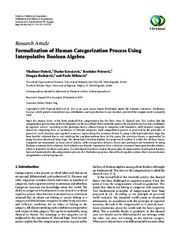Please use this identifier to cite or link to this item:
https://rfos.fon.bg.ac.rs/handle/123456789/1384| Title: | Formalization of Human Categorization Process Using Interpolative Boolean Algebra | Authors: | Dobrić, Vladimir Kovačević, Darko Petrović, Bratislav Radojević, Dragan Milošević, Pavle |
Issue Date: | 2015 | Publisher: | Hindawi Ltd, London | Abstract: | Since the ancient times, it has been assumed that categorization has the basic form of classical sets. This implies that the categorization process rests on the Boolean laws. In the second half of the twentieth century, the classical theory has been challenged in cognitive science. According to the prototype theory, objects belong to categories with intensities, while humans categorize objects by comparing them to prototypes of relevant categories. Such categorization process is governed by the principles of perceived world structure and cognitive economy. Approaching the prototype theory by using truth-functional fuzzy logic has been harshly criticized due to not satisfying the complementation laws. In this paper, the prototype theory is approached by using structure-functional fuzzy logic, the interpolative Boolean algebra. The proposed formalism is within the Boolean frame. Categories are represented as fuzzy sets of objects, while comparisons between objects and prototypes are formalized by using Boolean consistent fuzzy relations. Such relations are directly constructed from a Boolean consistent fuzzy partial order relation, which is treated by Boolean implication. The introduced formalism secures the principles of categorization showing that Boolean laws are fundamental in the categorization process. For illustration purposes, the artificial cognitive system which mimics human categorization activity is proposed. | URI: | https://rfos.fon.bg.ac.rs/handle/123456789/1384 | ISSN: | 1024-123X |
| Appears in Collections: | Radovi istraživača / Researchers’ publications |
Show full item record
SCOPUSTM
Citations
3
checked on Nov 17, 2025
Page view(s)
8
checked on Dec 14, 2025
Download(s)
2
checked on Dec 14, 2025
Google ScholarTM
Check
Altmetric
This item is licensed under a Creative Commons License


